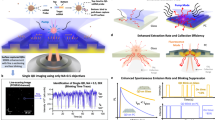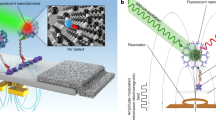Abstract
Optical multiplexing plays an important role in applications such as optical data storage1, document security2, molecular probes3,4 and bead assays for personalized medicine5. Conventional fluorescent colour coding is limited by spectral overlap and background interference, restricting the number of distinguishable identities. Here, we show that tunable luminescent lifetimes τ in the microsecond region can be exploited to code individual upconversion nanocrystals. In a single colour band, one can generate more than ten nanocrystal populations with distinct lifetimes ranging from 25.6 µs to 662.4 µs and decode their well-separated lifetime identities, which are independent of both colour and intensity. Such ‘τ-dots’ potentially suit multichannel bioimaging, high-throughput cytometry quantification, high-density data storage, as well as security codes to combat counterfeiting. This demonstration extends the optical multiplexing capability by adding the temporal dimension of luminescent signals, opening new opportunities in the life sciences, medicine and data security.
This is a preview of subscription content, access via your institution
Access options
Subscribe to this journal
Receive 12 print issues and online access
$209.00 per year
only $17.42 per issue
Buy this article
- Purchase on Springer Link
- Instant access to full article PDF
Prices may be subject to local taxes which are calculated during checkout





Similar content being viewed by others
References
Zijlstra, P., Chon, J. W. M. & Gu, M. Five-dimensional optical recording mediated by surface plasmons in gold nanorods. Nature 459, 410–413 (2009).
Jeevan, M. M. et al. Security printing of covert quick response codes using upconverting nanoparticle inks. Nanotechnology 23, 395201 (2012).
Li, Y. G., Cu, Y. T. H. & Luo, D. Multiplexed detection of pathogen DNA with DNA-based fluorescence nanobarcodes. Nature Biotechnol. 23, 885–889 (2005).
Lin, C. X. et al. Submicrometre geometrically encoded fluorescent barcodes self-assembled from DNA. Nature Chem. 4, 832–839 (2012).
Lu, J. et al. MicroRNA expression profiles classify human cancers. Nature 435, 834–838 (2005).
Schena, M., Shalon, D., Davis, R. W. & Brown, P. O. Quantitative monitoring of gene-expression patterns with a complementary-DNA microarray. Science 270, 467–470 (1995).
Thomson, J. M., Parker, J., Perou, C. M. & Hammond, S. M. A custom microarray platform for analysis of microRNA gene expression. Nature Methods 1, 47–53 (2004).
Nicewarner-Pena, S. R. et al. Submicrometer metallic barcodes. Science 294, 137–141 (2001).
Pregibon, D. C., Toner, M. & Doyle, P. S. Multifunctional encoded particles for high-throughput biomolecule analysis. Science 315, 1393–1396 (2007).
Braeckmans, K. et al. Encoding microcarriers by spatial selective photobleaching. Nature Mater. 2, 169–173 (2003).
Han, M. Y., Gao, X. H., Su, J. Z. & Nie, S. Quantum-dot-tagged microbeads for multiplexed optical coding of biomolecules. Nature Biotechnol. 19, 631–635 (2001).
Wang, F. et al. Tuning upconversion through energy migration in core-shell nanoparticles. Nature Mater. 10, 968–973 (2011).
Cunin, F. et al. Biomolecular screening with encoded porous-silicon photonic crystals. Nature Mater. 1, 39–41 (2002).
Cao, Y. W. C., Jin, R. C. & Mirkin, C. A. Nanoparticles with Raman spectroscopic fingerprints for DNA and RNA detection. Science 297, 1536–1540 (2002).
Bendall, S. C. et al. Single-cell mass cytometry of differential immune and drug responses across a human hematopoietic continuum. Science 332, 687–696 (2011).
Lander, E. S. et al. Initial sequencing and analysis of the human genome. Nature 409, 860–921 (2001).
Bartel, D. P. MicroRNAs: genomics, biogenesis, mechanism, and function. Cell 116, 281–297 (2004).
Pawson, T. & Nash, P. Assembly of cell regulatory systems through protein interaction domains. Science 300, 445–452 (2003).
Nicholson, J. K. & Lindon, J. C. Systems biology—metabonomics. Nature 455, 1054–1056 (2008).
Van't Veer, L. J. & Bernards, R. Enabling personalized cancer medicine through analysis of gene-expression patterns. Nature 452, 564–570 (2008).
Li, X., Lan, T.-H., Tien, C.-H. & Gu, M. Three-dimensional orientation-unlimited polarization encryption by a single optically configured vectorial beam. Nature Commun. 3, 998 (2012).
Perfetto, S. P., Chattopadhyay, P. K. & Roederer, M. Seventeen-colour flow cytometry: unravelling the immune system. Nature Rev. Immunol. 4, 648–655 (2004).
Cui, H. H., Valdez, J. G., Steinkamp, J. A. & Crissman, H. A. Fluorescence lifetime-based discrimination and quantification of cellular DNA and RNA with phase-sensitive flow cytometry. Cytometry A 52A, 46–55 (2003).
Watson, D. A. et al. A flow cytometer for the measurement of Raman spectra. Cytometry A 73A, 119–128 (2008).
Gnach, A. & Bednarkiewicz, A. Lanthanide-doped up-converting nanoparticles: merits and challenges. Nano Today 7, 532–563 (2012).
Wang, F. et al. Simultaneous phase and size control of upconversion nanocrystals through lanthanide doping. Nature 463, 1061–1065 (2010).
Lu, Y., Xi, P., Piper, J. A., Huo, Y. & Jin, D. Time-gated orthogonal scanning automated microscopy (OSAM) for high-speed cell detection and analysis. Sci. Rep. 2, 837 (2012).
Yang, L., Tran, D. K. & Wang, X. BADGE, BeadsArray for the detection of gene expression, a high-throughput diagnostic bioassay. Genome Res. 11, 1888–1898 (2001).
Yurkovetsky, Z. R. et al. Multiplex analysis of serum cytokines in melanoma patients treated with interferon-alpha 2b. Clin. Cancer Res. 13, 2422–2428 (2007).
Wang, F., Wang, J. & Liu, X. Direct evidence of a surface quenching effect on size-dependent luminescence of upconversion nanoparticles. Angew. Chem. Int. Ed. 49, 7456–7460 (2010).
Zhao, J. et al. Upconversion luminescence with tunable lifetime in NaYF4:Yb,Er nanocrystals: role of nanocrystal size. Nanoscale 5, 944–952 (2013).
Bastiaens, P. I. H. & Squire, A. Fluorescence lifetime imaging microscopy: spatial resolution of biochemical processes in the cell. Trends Cell Biol. 9, 48–52 (1999).
Heilemann, M. et al. High-resolution colocalization of single dye molecules by fluorescence lifetime imaging microscopy. Anal. Chem. 74, 3511–3517 (2002).
Acknowledgements
The authors thank D. Birch for sample characterization and F. Chi for technical assistance. This project was financially supported by the Australian Research Council (DP 1095465), the China Scholarship Council and Macquarie University Postgraduate Research Scholarships. Y.Lu and D.J. acknowledge the International Society for Advancement of Cytometry for support as ISAC Scholars. P.X. acknowledges support from the ‘973’ programme of China (2011CB707502, 2011CB809101). D.J. and A.S. acknowledge support through Macquarie University Vice-Chancellor's Innovation Fellowships.
Author information
Authors and Affiliations
Contributions
D.J., J.A.P., R.C.L. and J.P.R. conceived the project. D.J. designed the experiments and supervised the research. Y.Lu, J.Z. and D.J. were primarily responsible for data collection and analysis. Y.Lu, E.M.G. and D.J. prepared figures and wrote the main manuscript text. Y.Lu, J.Z., R.Z., D.L. and D.J. were primarily responsible for the Supplementary Information. All authors contributed to data analysis, discussions and manuscript preparation.
Corresponding author
Ethics declarations
Competing interests
The authors declare no competing financial interests.
Supplementary information
Supplementary information
Supplementary information (PDF 2763 kb)
Rights and permissions
About this article
Cite this article
Lu, Y., Zhao, J., Zhang, R. et al. Tunable lifetime multiplexing using luminescent nanocrystals. Nature Photon 8, 32–36 (2014). https://doi.org/10.1038/nphoton.2013.322
Received:
Accepted:
Published:
Issue Date:
DOI: https://doi.org/10.1038/nphoton.2013.322
This article is cited by
-
A 3D nanoscale optical disk memory with petabit capacity
Nature (2024)
-
Time-Resolved Imaging in Short-Wave Infrared Region
Journal of Shanghai Jiaotong University (Science) (2024)
-
Dual-band polarized upconversion photoluminescence enhanced by resonant dielectric metasurfaces
eLight (2023)
-
Ultra-wideband-responsive photon conversion through co-sensitization in lanthanide nanocrystals
Nature Communications (2023)
-
Orthogonal luminescence lifetime encoding by intermetallic energy transfer in heterometallic rare-earth MOFs
Nature Communications (2023)



